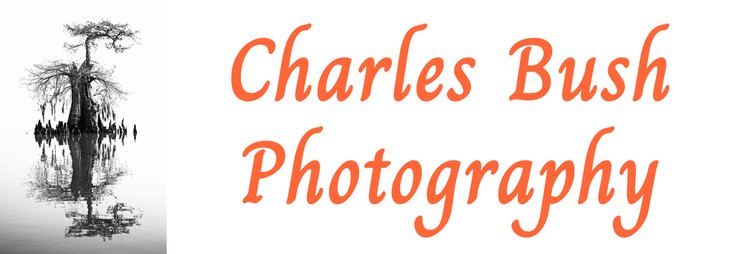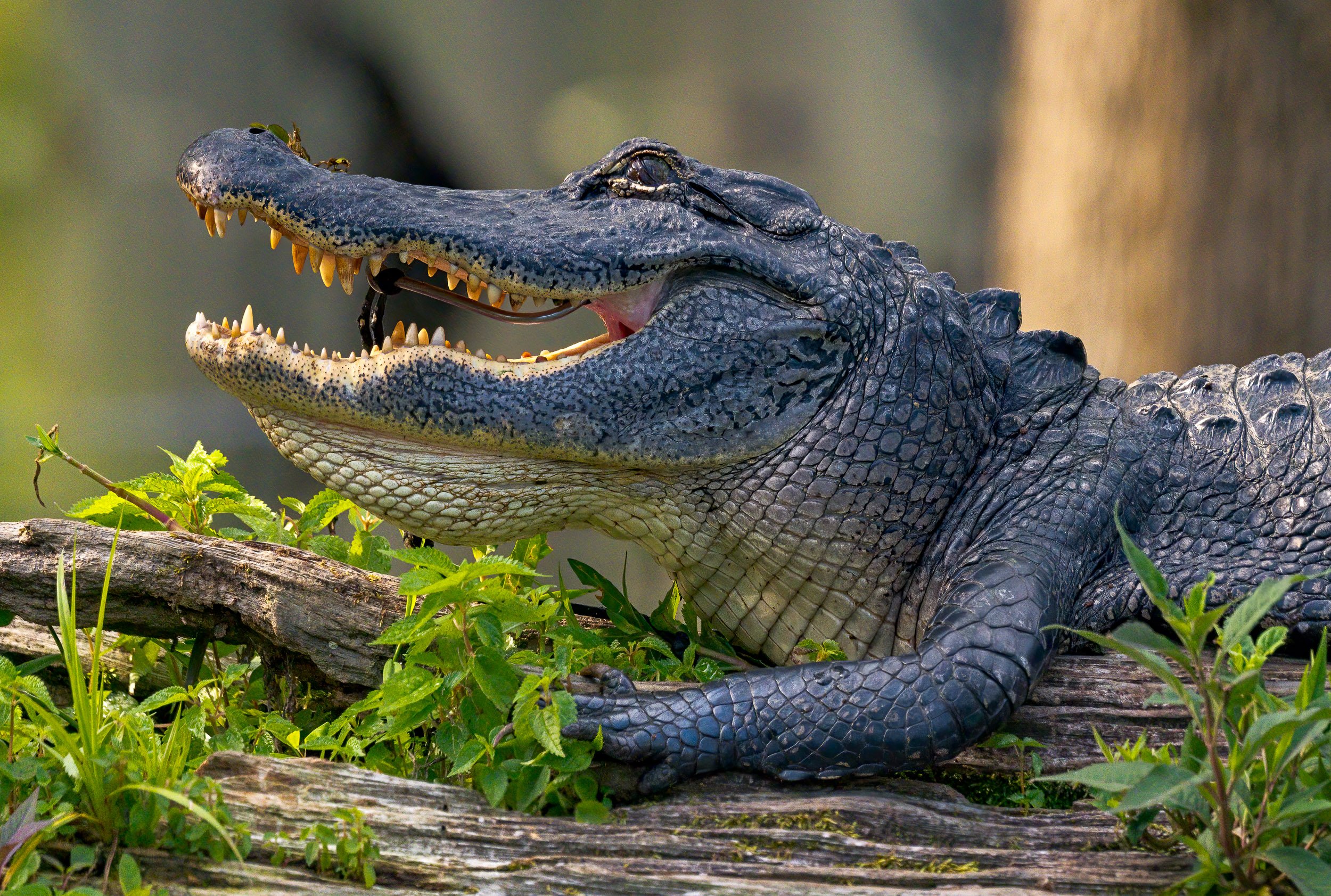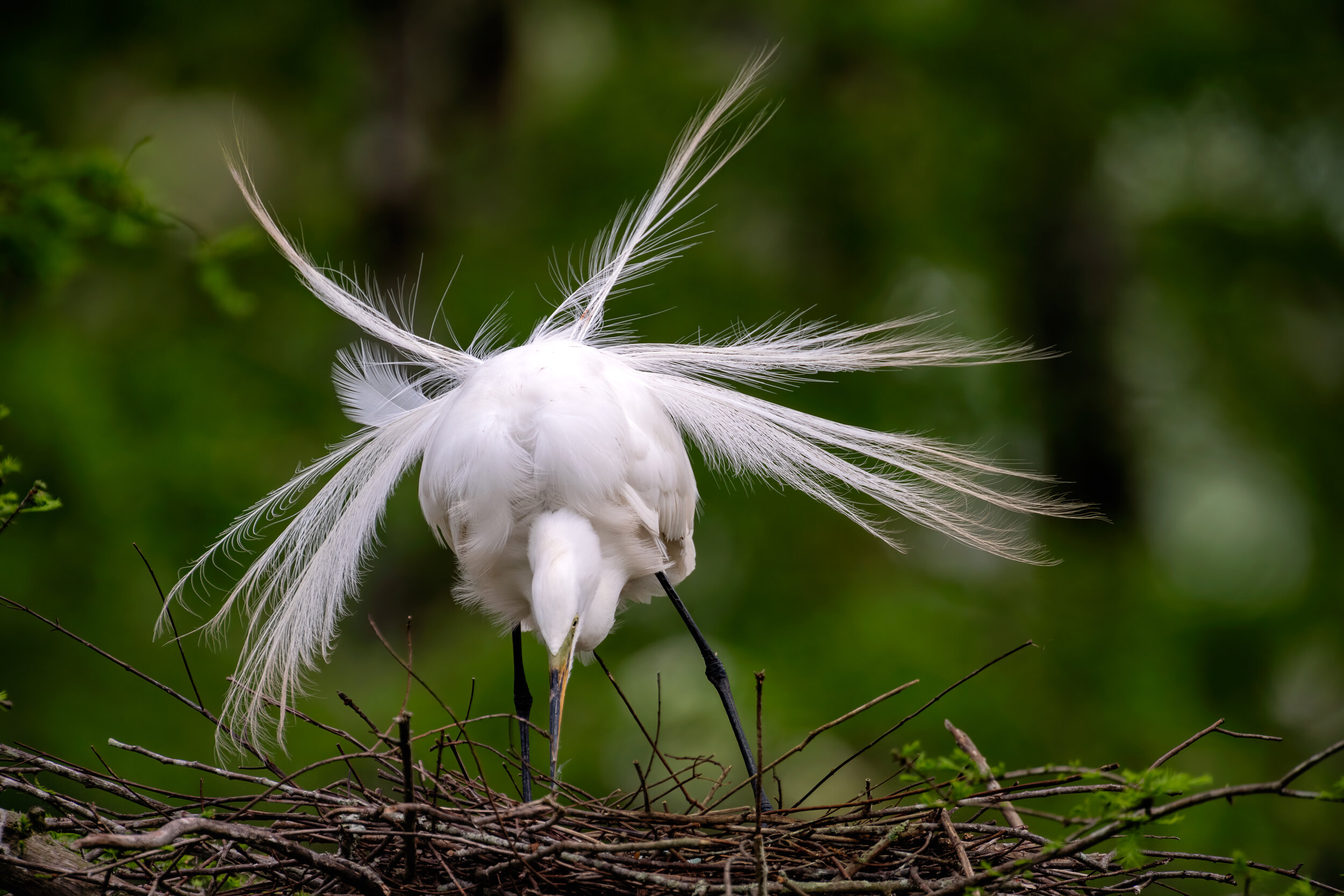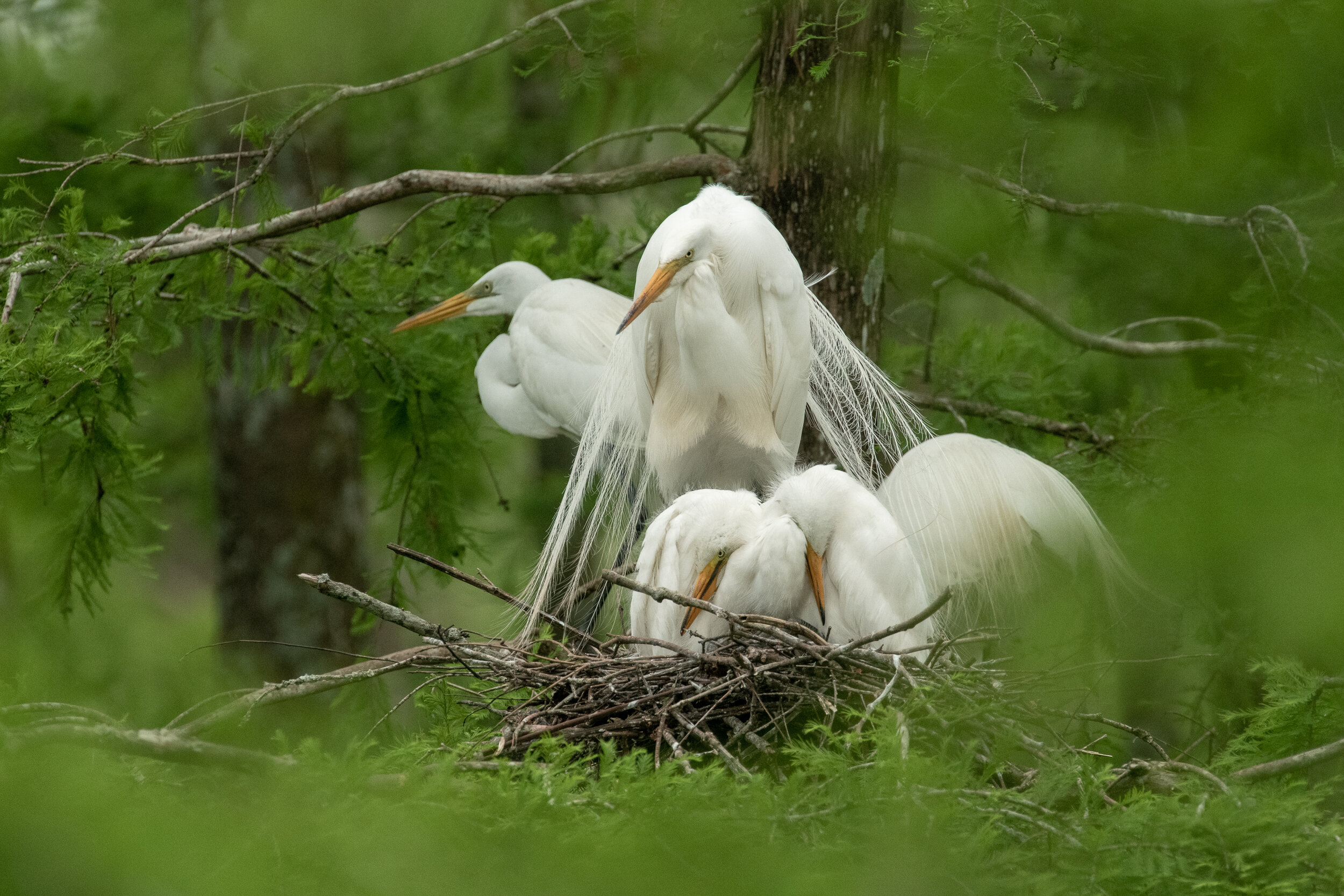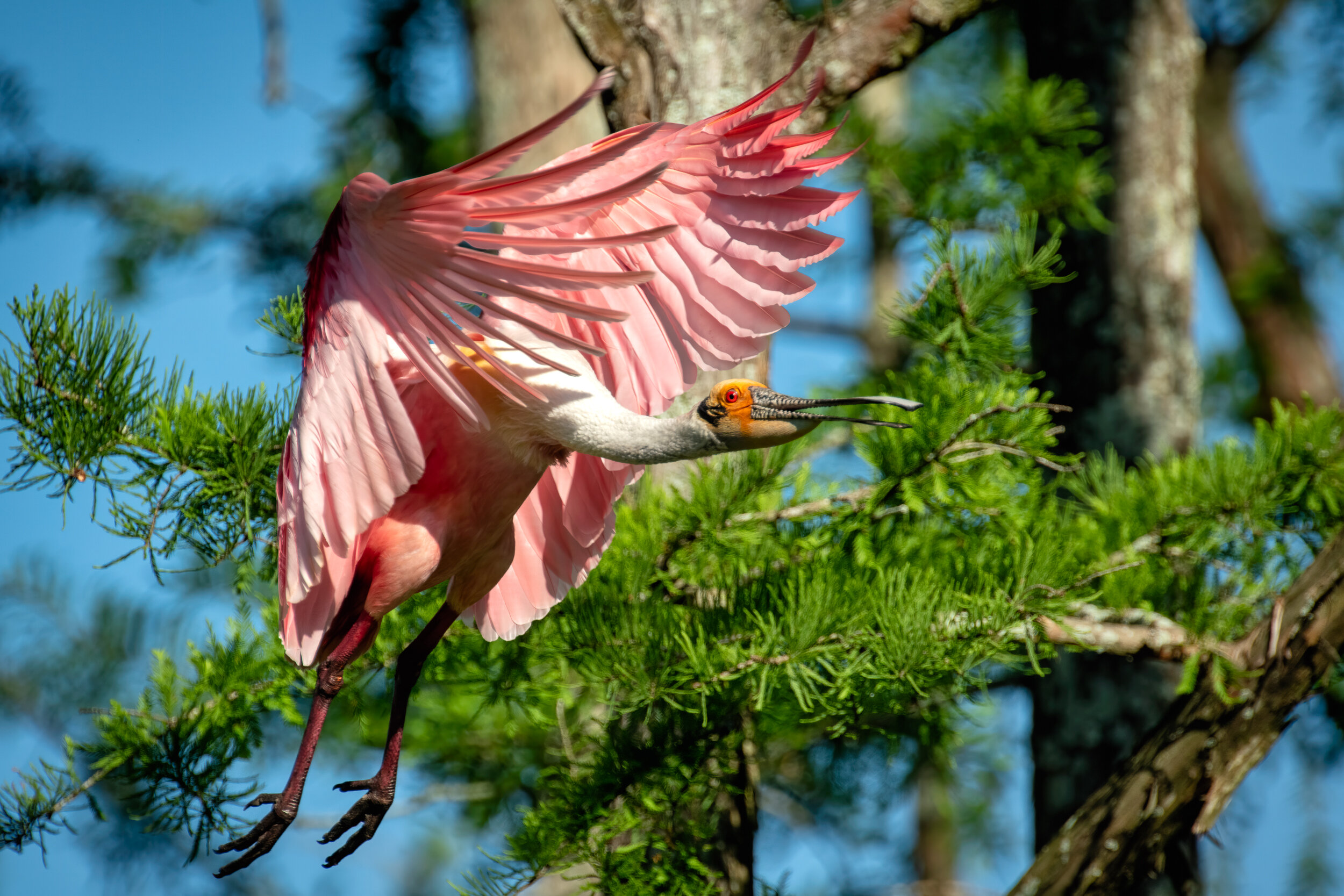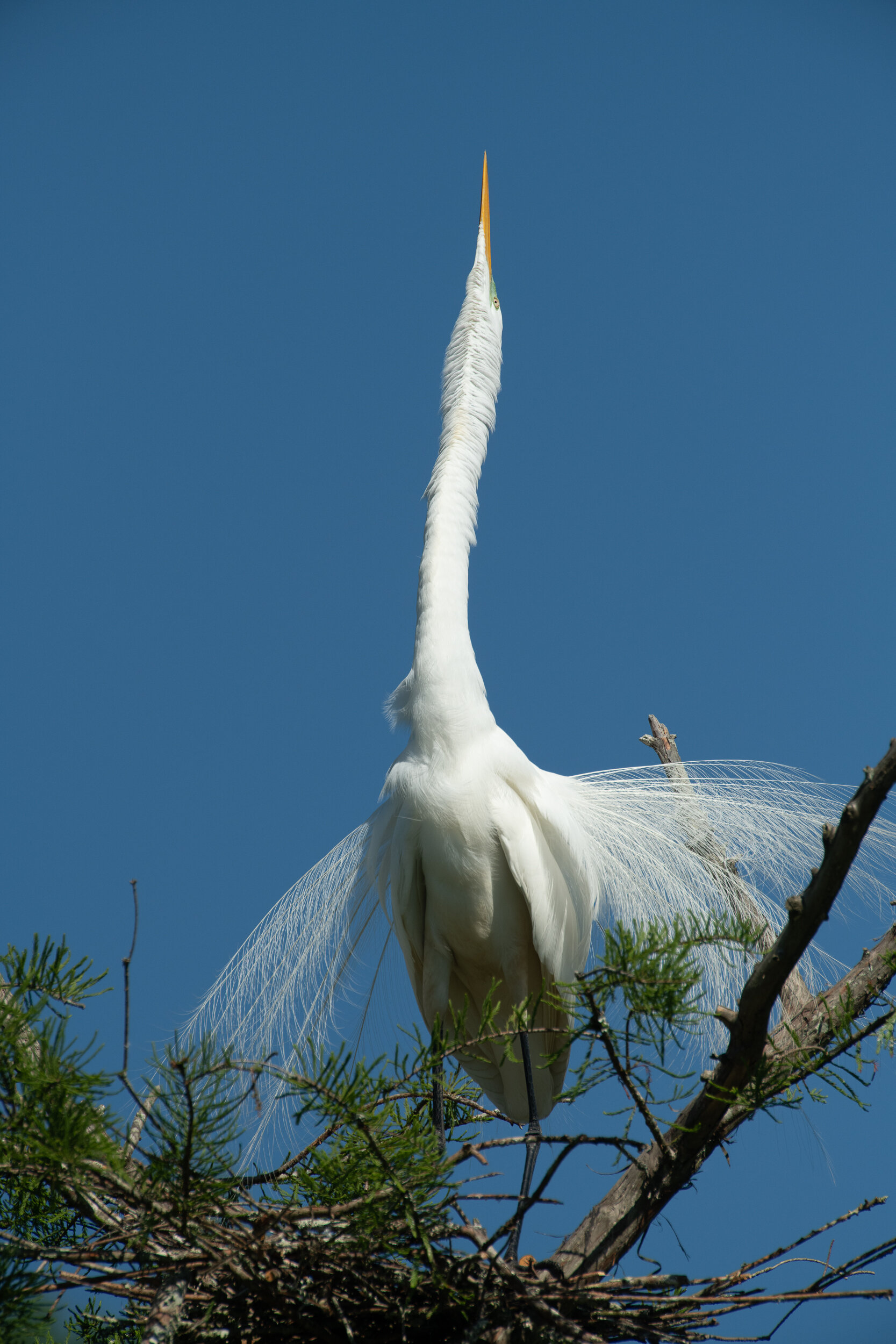A Great Egret in Fall Foliage–Lake Martin Louisiana, November, 2023
Sunset at Miller’s Lake May 2024
2024-09-16 Short Blog Post - Hurricane Followup
In the newsletter that I posted last week, I discussed my plans for protecting my computer and camera equipment from the approaching hurricane. Here's my account of what happened during and after the storm.
Read MoreThe decisive moment captured with my Z8 camera at a high frame rate
Continuing My Photography Journey as I Age
For 24 years, I used Nikon DSLR cameras and Nikkor lenses. My go-to lens for bird photography was the Nikkor AFS 600mm f/4 lens, which I bought in 1997. The camera, lens, and tripod head weighed almost 25 pounds, and lugging them around had become too much for me. Also, my hearing and eyesight were deteriorating, making me consider other options for pursuing my passion.
I am grateful for the technological advancements that allow me to create stunning images despite the challenges of aging. The evolution of camera technology, computer capabilities, and improvements in my health have all played significant roles in maintaining and enhancing my photographic journey.
Camera Developments That Enable Me to Continue Making Photographs
Self Portrait with my 600mm f/4 in 2007
New Lighter Mirrorless Cameras and High-Quality Light Telephoto Lenses
The shift to mirrorless cameras has been a game-changer. These cameras are significantly lighter and more compact than their DSLR counterparts, reducing the physical strain of carrying heavy equipment. Additionally, advancements in telephoto lenses mean I can have a long telephoto lens without the bulk, making it easier to capture distant subjects. I've been using the excellent Nikkor 600 mm and 800 mm Phase Fresnel (PF) lenses, which are a fraction of the weight of my 600 mm f/4, with superior results. The 600 mm PF lens can be comfortably used hand-held, and the 800 mm lens on a tripod and head are approximately ⅓ the weight of the 600 f/4 and, for short sessions, can also be hand-held.
Red Shouldered Hawk photographed hand-held in a boat with an 800mm PF lens
Incredible Subject Detection Autofocus
Modern autofocus systems are incredibly advanced, with subject detection capabilities that were unimaginable just a few years ago. These systems can quickly and accurately lock onto subjects, whether birds in flight or fast-moving animals, ensuring sharp and focused images with minimal effort on my part. The camera's ability to track a bird's eye enables me to nail the focus, although my reflexes and vision are not as good as they were.
High Frame Rate and Large Buffer Capacity
The ability to shoot at high frame rates with large buffer capacities allows me to capture fast-action sequences effortlessly. This is particularly useful in wildlife photography, where every millisecond counts. With my Z8, I can take 20 Frames per second, increasing the likelihood of getting the perfect shot.
Improved Noise Performance
Advancements in sensor technology have greatly improved noise performance, allowing me to shoot at higher ISO settings without compromising image quality. This is crucial for low-light conditions and ensures that my images remain clear and detailed, even in challenging lighting situations.
Improved Vibration Reduction
Image stabilization technology has advanced significantly, significantly reducing the effects of camera shake. This is especially beneficial when shooting handheld and using a tripod when it is not feasible. Improved vibration reduction ensures that my images are sharp and blur-free, regardless of the circumstances.
Landscape Photography The new technology has benefited not just bird photography. Electronic Viewfinders have improved the ability to see and focus in dim light, and focus peaking indicators enable me to view what is and is not in focus even though my vision is not as good as it once was.
Computers That Enable Me to Continue Making Photographs
Improved Computer Capacity and Speed
The increased computer processing power and storage capacity have revolutionized how I handle and edit my photographs. I can process large RAW files quickly and efficiently, allowing a seamless workflow from shooting to final edits. This has become essential as the resolution of modern cameras continues to increase.
Incredible Noise Reduction Software
Advanced noise reduction software has enabled me to shoot at much higher ISO settings, enabling higher shutter speeds and improving the keeping rate of fast-moving subjects. This software effectively reduces noise without sacrificing image quality, allowing me to produce clean and detailed photographs even in less-than-ideal lighting conditions.
Mockingbird Photographed at ISO 12,800 to freeze the action
High-Quality Sharpening Software
The latest sharpening software can mitigate motion and focus blur, enhancing my images' overall sharpness and clarity. This technology is invaluable for ensuring that my photographs are as crisp and detailed as possible, even if the original shot was slightly off.
Health
Cataract Surgery
Undergoing cataract surgery has significantly improved my vision, allowing me to see details more clearly. This enhancement in my ability to see has directly impacted my photography, as I can now better identify and focus on subjects, leading to more precise and accurate shots.
In addition, the surgery improved my color vision, prior to the surgery, I had a yellow green color csst on everything, effecting the way I processed images, now with the improved color vision, images that I've processed should appear more accurate to others viewing them.
Hearing Aid
With the help of a hearing aid, I can now hear birds and other wildlife more clearly, aiding in locating and identifying subjects. Improved hearing has enriched my overall experience in nature and allowed me to capture moments I might have otherwise missed.
Conclusion
The intersection of advancing technology and personal health improvements has enabled me to continue creating beautiful photographs as I get older. As the tools at my disposal evolve, I remain excited and motivated to explore new photographic opportunities and capture the world around me with renewed clarity and enthusiasm.
A close-up of an Osprey taken with a Nikon D500 and a Nikkor 300mm f/4 pf lens
Bird Photography Equipment on a Budget (2024 Update)
This article updates my 2015 and 2020 articles, incorporating recent developments in the camera industry. The good news is that the shift by major manufacturers to mirrorless cameras with new lens mounts has created a market rich with bargains for excellent DSLR systems. While the upper-end mirrorless systems bring fast frame rates and subject-detecting autofocus modes, they are expensive. Quite competent DSLR systems can be purchased and used for a fraction of the cost, as many photographers are selling their DSLRs to upgrade to mirrorless systems.
Read MoreImage Culling, Rating, Backup and Importing Reassessment

Gremlins Ahead–Warning Long Geeky but Important Article
I’ve been investigating alternatives to Photo Mechanic for Downloading, Culling, and Keywording Photographs; this post explores this in detail. To summarize, while the alternative workflow with Fast Raw Viewer and A Better Finder Rename is more complex and time-consuming, it offers:
True raw histogram and accurate exposure information.
Shadow and highlight clipping percentages.
Focus peaking overlays.
Extensive EXIF data visibility during culling.
More complex renaming options.
One-time versus expensive subscription model.
Despite the longer processing times and the need for multiple applications, this setup is a viable alternative to Photo Mechanic for my use. Due to its speed and advanced keywording capabilities, Photo Mechanic remains superior for time-sensitive events. Therefore, I decided to use Fast Raw Viewer and A Better Finder Renames, while Photo Mechanic is best for photographers requiring urgent, time-critical workflows.
Read MoreEarly Morning in the Boat at Lake Dauterive
A Memorable Two-Day Tour: Capturing the Beauty of Lake Dauterive–November 2023
Last fall, I had the pleasure of leading a private two-day tour that took us to Henderson Swamp and the breathtaking Lake Dauterive. While Henderson Swamp was a delight, Lake Dauterive truly stole the show. Known for its stunning mist and thick fog, we were fortunate to experience both during our visit, capturing some remarkable photographs, including an eagle in flight. Click the link to read and see more images.
Read MoreSunset at Miller’s Lake using a 600mm Lens
Sunset at MIller's Lake
Capturing the Golden Hour: A Memorable April Tour
Sunset happened after a wonderful photo session of birds on our April Tour. The sky was a canvas of vibrant hues, a perfect backdrop for the day's final shots. As the sun dipped near the horizon, it cast a golden glow over the landscape, enhancing the beauty of the avian subjects we were so eager to capture.
My favorite shot was taken using a 600mm telephoto lens. I was trying to get birds in front of the sun but to no avail. However, I love this shot. The Pattern of the clouds and the sun large in the frame
Read MoreOwl eating crawfish
An Owl Eating Crawfish
As Louisianians, we have a fondness for consuming crawfish. Interestingly, we are not alone in our appreciation for this delicacy - even our winged companions seem to share our love for it. During one of my outings, I came across a duo of Owls who were taking turns catching crawfish from the nearby lake. They would either consume it themselves or offer it to their partner. I have witnessed similar behavior at Lake Martin before, where a group and I once observed an Owl repeatedly diving into the water for over an hour to catch and devour crawfish.
Read MoreInfrared photograph of a Tupelo Tree at Millers Lake
Infrared photograph of a Tupelo Tree at Millers Lake
Here’s a stunning infrared photo of the Tupelo Tree at Miller’s Lake. The image features a high-contrast black-and-white effect with light foliage and dark clouds in the background. You can also spot some birds in the distance, adding to the lake’s serene beauty.
Read MoreBlack-Bellied Whistling Duck - from rare to abundant
When I returned to Louisiana in 2001, seeing a Black-Bellied Whistling Duck was rare. Since then, the population has rapidly increased to the point that it is the most common duck I see.
Read MoreAlligator with Hunting Hook
On the last day of my May photo tour, we encountered this giant alligator on a log. While making a photograph, we noticed a large hook in its mouth. The poor creature managed to evade the hunter's snare but now is living with this hook.
Bird Photography in Southern Louisiana, a PDF Guide
I've greated a guide on when and where to photograph birds in Southern Louisiana. I'm selling the guide for $29.99. If you plan on visiting Louisiana to photograph birds this is a handy reference. The link to purchase and download the guide is here.
Reminder Reset your Camera's to Daylight Savings Time
Once again, we change to daylight savings time. Make sure to reset the time in your camera along with your clocks.
Read MorePelican in Flight–Terrebonne Parish 2021-03-14
It's time to set your camera to Daylight Savings Time
Reminder the time changes this weekend, set your camera to daylight savings time.
2020-03-15 Photo Trip
Day one of a 3 day trip. On the way in I checked on Jefferson Island. There's good news and bad news.
Read MoreSunset–Lake Fausse Pointe
It's time to set your camera to Daylight Savings Time
Reminder the time changes this weekend, set your camera to daylight savings time.
A Foggy Morning in the Swamp (40” x 60”) Hanging at Back to Normal Physical Therapy
Charles Bush Photography Blog Post
I want to thank my friends at Back to Normal Physical Therapy for purchasing a 40" x 60" print of my "A Foggy Morning in the Swamp" photograph taken during my December Photo Tour at Lake Dauterive. Click below to read details about preparing the image and where and how it was printed.
Read MoreCharles Bush Photography Blog Post
This afternoon I received an email from Kristi Enricke at Cazan Lake. She sent along with a picture with Great Egrets in the Rookery. Last year this was the best shooting on our Spring tours. Hopefully, I can get up there soon and check things out. I'm excited that the spring shooting is starting this early, I'm expecting a good year.
Read More